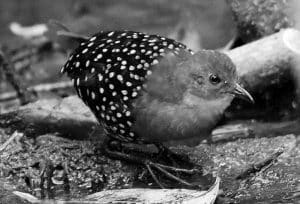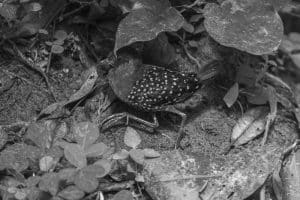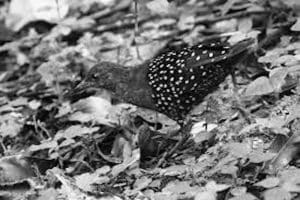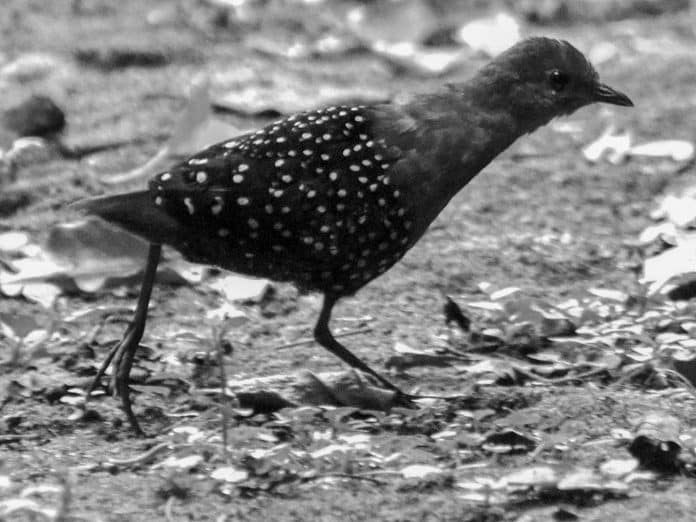Introduction to the white-spotted flufftail
The white-spotted flufftail (Sarothrura pulchra) is a small and elusive bird species that can be found in the beautiful country of Tanzania. This striking bird is known for its unique appearance, with distinct white spots on its dark brown plumage. The white-spotted flufftail in Tanzania is a member of the rail family and is highly sought after by birdwatchers and nature enthusiasts.
Habitat and distribution of the white-spotted flufftail in Tanzania

The white-spotted flufftail is endemic to the wetlands and marshes of Tanzania, making it a true gem of this East African nation. It can be found in various regions across the country, including the Serengeti National Park, the Selous Game Reserve, and the Mahale Mountains National Park. These birds prefer dense vegetation near water bodies, such as swamps and riverbanks, where they can find shelter and food.
The challenges of spotting the white-spotted flufftail
Spotting the white-spotted flufftail can be quite challenging due to its secretive nature and preference for dense vegetation. These birds are masters of camouflage and can easily blend in with their surroundings, making them difficult to locate. Furthermore, their shy behavior and tendency to remain hidden in the undergrowth add to the challenge of finding them.
To increase your chances of spotting a white-spotted flufftail, it is important to have a keen eye and a patient disposition. Many birdwatchers spend hours patiently waiting near marshes and wetlands, hoping for a glimpse of this elusive species. It’s also helpful to familiarize yourself with their distinctive call, as it can guide you to their location.
Birdwatching tips for finding the white-spotted flufftail
If you’re determined to spot the white-spotted flufftail in Tanzania, here are some useful tips to enhance your birdwatching experience:
- Research the best time and season: White-spotted flufftails are more active during the early morning and late afternoon. Plan your birdwatching trips accordingly, and consider visiting during the dry season when vegetation is less dense, making it slightly easier to spot these birds.
- Learn their call: The white-spotted flufftail has a distinctive call that resembles a series of high-pitched whistles. Familiarize yourself with this sound by listening to recordings or joining birding groups that can help you identify the call.
- Look for wetland habitats: White-spotted flufftails are commonly found near wetlands and marshes. Focus your birdwatching efforts in these areas, paying attention to dense vegetation and areas with ample water sources.
- Patience is key: Spotting rare birds like the white-spotted flufftail requires patience and perseverance. Be prepared to spend long periods quietly observing and waiting for the bird to reveal itself.
Birding hotspots in Tanzania for sighting the white-spotted flufftail

Tanzania is a birdwatching paradise, offering a wide range of habitats and hotspots for bird enthusiasts. Here are some notable locations where you have a chance of sighting the white-spotted flufftail:
- Serengeti National Park: Known for its iconic wildlife and vast savannahs, the Serengeti also provides opportunities to spot the white-spotted flufftail. Explore the park’s wetland areas, such as the Grumeti River and the Seronera River Valley, for a chance to see this elusive bird.
- Selous Game Reserve: This vast reserve is home to an abundance of wildlife, including the white-spotted flufftail. The Rufiji River and its surrounding wetlands are prime locations for birdwatching and offer excellent chances of spotting this rare species.
- Mahale Mountains National Park: Located on the shores of Lake Tanganyika, Mahale Mountains National Park is renowned for its population of chimpanzees. However, it is also a haven for birdwatchers, with opportunities to spot the white-spotted flufftail along the park’s rivers and streams.
Conservation efforts for the white-spotted flufftail in Tanzania
Due to its limited distribution and habitat requirements, the white-spotted flufftail is considered a vulnerable species. Efforts are being made to protect its natural habitats and raise awareness about its conservation needs. Organizations such as the Tanzania Bird Atlas and the Wildlife Conservation Society work to monitor the population and conserve the wetland habitats crucial for the survival of this bird.
Conservation initiatives involve habitat restoration, community engagement, and research to better understand the species’ ecology and behavior. It is crucial for visitors and locals alike to support these efforts by respecting the bird’s habitat, avoiding disturbance, and promoting sustainable tourism practices.
Other rare bird species in Tanzania
Tanzania is home to an incredible diversity of bird species, with over 1,000 recorded in the country. Aside from the white-spotted flufftail, there are several other rare bird species that birdwatchers can look out for, including:
- Grey-breasted spurfowl (Pternistis rufopictus): Endemic to Tanzania, this bird can be found in the Udzungwa Mountains and the Eastern Arc Mountains. It has a distinctive grey breast and is known for its beautiful vocalizations.
- Fischer’s lovebird (Agapornis fischeri): This colorful parrot is native to Tanzania and is highly sought after by bird enthusiasts. It can be found in the Arusha National Park and the Ngorongoro Conservation Area.
- Pemba scops owl (Otus pembaensis): One of Tanzania’s rarest birds, the Pemba scops owl is found only on the island of Pemba. It is a nocturnal species and is known for its unique vocalizations.
Recommended birding tours and guides for spotting the white-spotted flufftail

To maximize your chances of encountering the white-spotted flufftail in Tanzania, it is advisable to join specialized birding tours or hire experienced bird guides. These professionals have extensive knowledge of the bird’s behavior, habitat, and vocalizations, increasing the likelihood of a successful sighting.
Some reputable birding tour operators in Tanzania include Birding Pal, Tropical Birding, and Nature Discovery. These companies offer customized birding itineraries that cater to both beginners and experienced birdwatchers. Additionally, local bird guides, such as those certified by the Tanzania Bird Guides Association, can provide invaluable insights and assistance in locating the white-spotted flufftail.
Personal experiences and stories of birders who have spotted the white-spotted flufftail
Birders who have had the privilege of spotting the white-spotted flufftail in Tanzania often describe the experience as exhilarating and rewarding. The thrill of finally catching a glimpse of this elusive bird after hours of patient waiting is unmatched.
One birder, Sarah Thompson, recounts her encounter with the white-spotted flufftail in the Selous Game Reserve: “I was standing quietly near a marsh, scanning the dense vegetation, when I heard a faint whistle-like call. My heart raced as I followed the sound, and suddenly, there it was – a white-spotted flufftail perched on a reed. Its distinctive plumage and beautiful markings were even more breathtaking in person. It was a moment I’ll never forget.”
These personal stories serve as a testament to the allure and excitement of encountering the white-spotted flufftail firsthand.
Conclusion: The thrill of encountering the white-spotted flufftail in Tanzania
Spotting the elusive white-spotted flufftail in Tanzania is an extraordinary birding experience that combines the excitement of a treasure hunt with the beauty of the country’s diverse landscapes. While finding this rare species may pose challenges, the reward of witnessing its unique appearance and behavior makes the effort worthwhile.
By exploring the birding hotspots of Tanzania, learning about its conservation efforts, and seeking the assistance of experienced guides, you can increase your chances of encountering this elusive bird. Remember, patience, persistence, and a deep appreciation for nature are key ingredients for a successful birdwatching adventure in Tanzania.
So, pack your binoculars, immerse yourself in the stunning natural wonders of Tanzania, and embark on a journey to discover the elusive white-spotted flufftail.

































